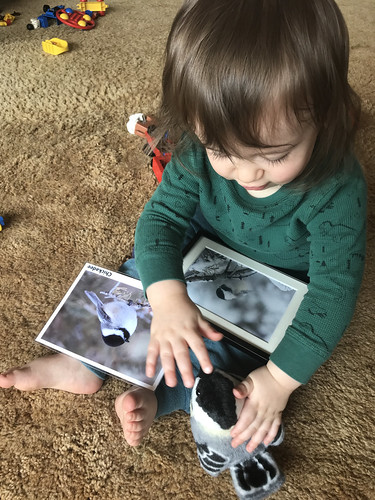Scott Weidensaul’s wonderful A Warbler’s Journey is being released this week, making me think more about children’s picture books. All three of my kids loved Richard Scarry’s Best Word Book Ever and The Sesame Street Word Book, both of which were great vocabulary builders and allowed us opportunities to explain farms, construction work sites, big cities, firefighting, and other situations the kids hadn’t experienced firsthand, and led to fun improvisation as we all made up stories around the pictures. But unfortunately, these word books were limited when it came to natural history. The Sesame Street book had a few nice pigeon illustrations and even showed Bert looking at them with binoculars, and it had a couple of tiny robin pictures, and both books showed farm ducks and chickens, but otherwise, they didn’t focus on real-life birds.
My kids did have several books about animals with high-quality illustrations. Text in these was minimal, which I think is best. Like other word books, these expanded my children’s concepts and vocabulary and opened their eyes to creatures they could look for in their own backyards or when we went to Grandma and Grandpa’s house in the northern Wisconsin woods. I never considered buying books that put cute or misleading words into the mouths of realistic-looking birds, though oddly enough I was fine with some very unrealistic cartoons and silly works of fiction. We could all be charmed by the community of friendly woodland creatures in Disney’s Sleeping Beauty while understanding that real bunnies and squirrels are wise to steer clear of Great Horned Owls. I know how important it is for children to learn about whales, polar bears, lions, tigers, pandas, ostriches, and penguins, but I'll never understand why these exotic creatures are shown in so many more books for small Midwestern children than gray squirrels, chickadees, jays, or crows.
While Joey was still an only child, I made him his own book about nature, Animals at Joey’s House, using magazine photos and pictures from posters I’d used in my classroom showing birds and mammals we’d seen in our yard and family snapshots of two other animal species in our yard, us and our dog. I coated the pages in clear contact paper. The book sort of held up over the years despite the colored inks bleeding a bit, but it looks horribly primitive and incomplete compared to the kind of books I could have printed now at fairly low cost using my own photos. Back then I wasn't photographing birds or other animals.
So far I haven’t made any books about the animals Walter can see in his yard. This time around, I've been making something more flexible and timely than any book could be.
Long, long ago, when I was a teacher, the schools I taught in didn’t have the resources to purchase field guides for every kid. When we took bird walks, passing around my own field guide so everyone could see how a particular bird was depicted while the real bird was still there just didn’t work. It took a few seconds for me to find the page with the bird, and then each kid would have to look through four or five species on that page to pick out the right one, compare how it was depicted with the real thing, and hand off the field guide to the next kid until someone lost the page—then I’d have to start all over. The pages of the field guide everyone liked most, the Golden Guide, fell out with heavy use, but that turned out to be a feature, not a bug—I cut up those falling-out pages and made flash cards. Before heading out on a bird walk, I picked out the cards of birds I anticipated seeing. It took a few seconds to pull out the right one, but then it was easy for the kids to pass it around.
Remembering that inspired me to create picture cards for Walter. I make 5x7 labeled prints of my own photos of birds and mammals we've seen together, such as chickadees, crows, squirrels, rabbits, and deer, and encase them in durable plastic sleeves. I add new picture cards whenever I want, and he plays with them every day.
As Walter gets older and I have time, I’ll almost certainly make him some actual books using the print services now available. Some of them might be nice for other children, too, but my goal is making creations that are meaningful for this particular little person. Right now, I’m delighted that he likes my photos and thrilled that he has already seen so many wild alive creatures. This one-year-old child is starting out life with a much firmer sense of animals than I had even as a young adult, and that makes me very happy.




